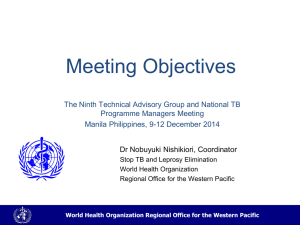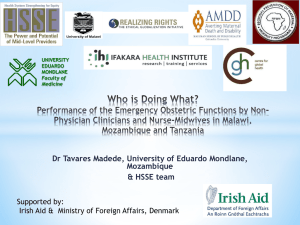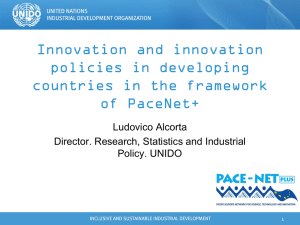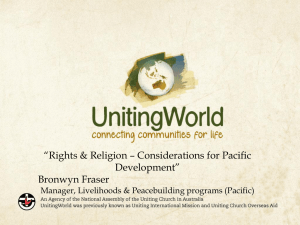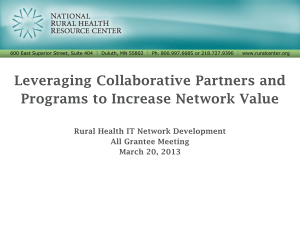Neonatal Resuscitation
advertisement
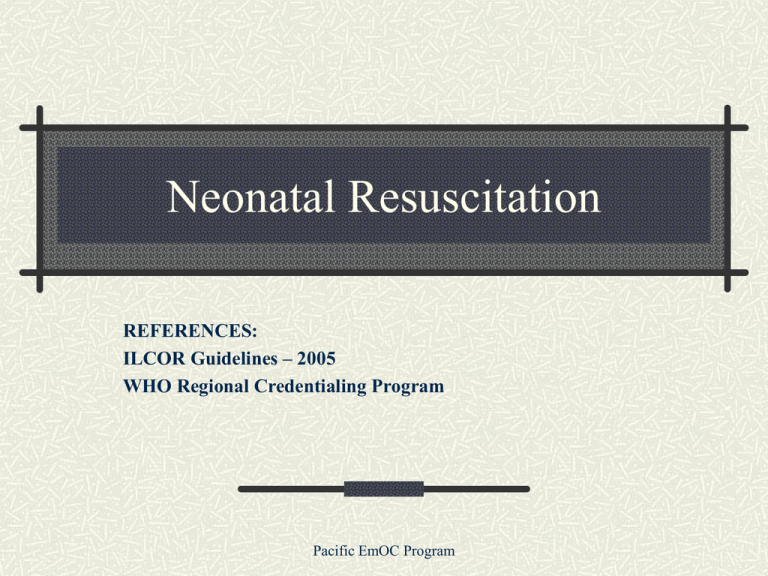
Neonatal Resuscitation REFERENCES: ILCOR Guidelines – 2005 WHO Regional Credentialing Program Pacific EmOC Program Objectives • Identify of infants “at risk” for asphyxia • Discuss effects of asphyxia • Describe Resuscitation of newborn – Equipment – Bag and mask ventilation – Cardiac compressions – Post resuscitation care Pacific EmOC Program How many infants might require active resuscitation? 10% require some degree of active resuscitation For up to 50% of this group there are no “risk factors” Staff attending deliveries may be faced with an unexpectedly “flat” infant Pacific EmOC Program Antepartum Risks Maternal diabetes Chronic maternal illness Cardiovascular Thyroid Neurological Pulmonary renal Pre eclampsia Maternal infection Polyhydramnios Oligohydramnios Premature rupture of membranes IUGR/preterm Fetal malformation Maternal substance abuse No antenatal care Post term gestation Multiple gestation Anaemia Age <16 or > 35 Pacific EmOC Program Intrapartum Risks Emergency CS Instrumental delivery Abnormal position Premature labour Precipitous labour Chorioamnionitis Prolonged rupture of membranes Prolonged labour > 24 hrs Prolonged 2nd stage of labour Fetal bradycardia Non-reassuring fetal heart rate pattern General anaesthesia Narcotics administered within 4 hours of delivery Meconium stained liquor Prolapsed cord Abruptio placentae Placenta previa Pacific EmOC Program Fetal asphyxia Primary apnoea Apnoeic Blue Heart rate Resuscitate easily Secondary Pacific EmOC Program apnoeic White, floppy Heart rate Blood pressure Require active resuscitation eg IPPV to survive Always assume infant has secondary Apnoea & commence Resuscitation Pacific EmOC Program Equipment Needed for Resuscitation Radiant warmer Warm towel and blankets Resuscitation bag and mask Self inflating bag Anaesthetic bag Endotracheal tubes Laryngoscope Stethoscope Oxygen source and tubing Suction source and tubing Drugs and fluids Syringes, needles, cannulae, IV lines +/-Umbilical lines Pacific EmOC Program ILCOR Guidelines for Neonatal Resuscitation 2005 Pacific EmOC Program Steps in Resuscitation - ABCDE Warmth and stimulation and assessment for the 1st 30 seconds Use warm cloth Replace when wet Rapidly assess Tone Colour Respiratory effort Pacific EmOC Program Steps in Resuscitation - ABCDE Airway Clear airway if required Removal of secretions if present Suction mouth and nose (only what you can see) No more than 5cms for no longer than 5 secs Negative pressure 100 mmHg (5litres) DO NOT SUCTION IF AIRWAY IS CLEAR Positioning Supine or lateral Head in neutral or slightly extended position Pacific EmOC Program Steps in Resuscitation - ABCDE Breathing Assessment of respiratory effort and colour Indications for oxygen administration Cyanosis Respiratory distress Give free flowing oxygen 5L/min Pacific EmOC Program Breathing: Indications for positive pressure ventilation Apnoea Gasping respiration HR < 100 bpm Persistent central cyanosis despite 100% O2 40-60 breaths/min No response Pacific EmOC Program Steps in Resuscitation - ABCDE Circulation Assessment of heart rate and response to previous measures Umbilical arteries Apex beat Auscultation Pacific EmOC Program Chest Compressions HR < 60 bpm despite adequate vent with 100% O2 for 30 seconds 2 techniques 2 thumb (preferred) 2 finger 3:1 ratio 1/3 of AP diameter Pacific EmOC Program Steps in resuscitation - ABCDE Drugs Adrenaline Volume Expanders Naloxone Pacific EmOC Program Adrenaline HR < 60 bpm after 30 seconds of adequate ventilation and chest compressions 0.1 - 0.3 mL kg of 1:10,000 Give via ETT, UVC, IV Repeat dose if no response after 60 seconds Pacific EmOC Program Volume expanders Not given routinely Useful in hypovolemia Suspected where there is a pale tachycardic infant Normal saline 10mL/kg over 5-10 mins UVC, IV If haemorrhagic shock is suspected give whole blood or packed red cells Pacific EmOC Program Naloxone Narcotic antagonist Inadequate spontaneous respiratory effort Mothers who received narcotics within 4 hrs of delivery 0.1mg/kg of a 0.4 mg/mL solution ETT, IV, UVC, IM, SC Monitor baby’s respirations for further respiratory depression Pacific EmOC Program Steps in resuscitation- ABCDE Environment Reduce draughts Shut doors and windows Turn on radiant warmer Warm blankets/bunny rugs/hat/plastic wrap for pre terms Pacific EmOC Program Meconium liquor ILCOR guidelines 2005 – no evidence to suction mouth and nose on perineum If baby vigorous and crying - normal care & observation If baby not vigorous – view cords and suction trachea under direct vision with laryngoscope & mec aspirator or wide bore catheter Cease suctioning if return is clear or Heart Rate 60 Observe post resuscitation for signs of respiratory distress Pacific EmOC Program

